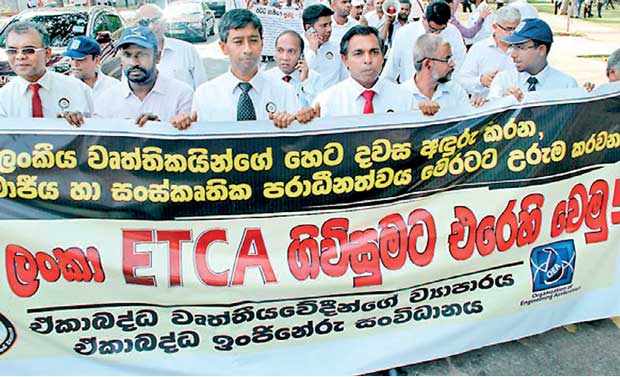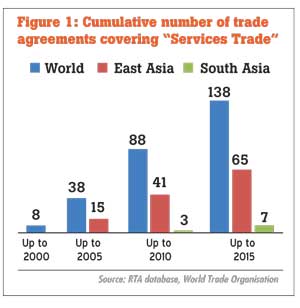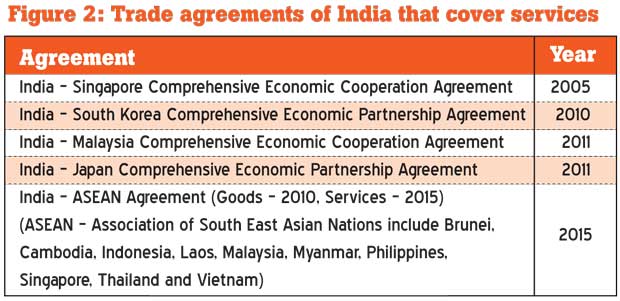09 Mar 2016 - {{hitsCtrl.values.hits}}

 Two previous Verité Insights titled ‘Sri Lanka missing world’s biggest trade party and it’s in her backyard’ and ‘Trade agreements that don’t deliver the goods’ published in May and June 2013 pointed out that Sri Lanka is well behind her Asian neighbours in entering into trade agreements and that those entered into were also deficient.
Two previous Verité Insights titled ‘Sri Lanka missing world’s biggest trade party and it’s in her backyard’ and ‘Trade agreements that don’t deliver the goods’ published in May and June 2013 pointed out that Sri Lanka is well behind her Asian neighbours in entering into trade agreements and that those entered into were also deficient.
This Insight shows that this is even more so the case with agreements that go beyond trade in goods to cover trade in services. This observation does not give a green light to the Economic and Technical Cooperation Agreement (ETCA) with India but it does provide some context. Even though the ETCA-type agreements are ‘new territory’ for Sri Lanka, many of its neighbours in Asia have been quite vigorous in entering into such goods and services agreements in the last decade.

The current debate on the ECTA is around whether Sri Lanka should go ahead with the agreement or not. However, the important question to ask is what costs and benefits could accrue to Sri Lanka and how that can be managed by the scope and structure of the agreement. Whether a trade agreement is beneficial or not depends greatly on those details. The experience with the existing free trade agreements (FTAs) suggests that Sri Lankan negotiators need to pull up their socks and act with greater acumen than in the past to secure benefits.
Trend towards trade in services
Before the turn of the century, there were only eight trade agreements in the world covering trade in services. But the number of agreements has increased exponentially since then. As of February 1, 2016, according to the World Trade Organisation (WTO), there are 138 trade agreements in the world covering both trade in goods and trade in services. This means that one third of the 419 trade agreements in force today in the world, is agreements covering trade in services.
East-Asia is leading the charge: It is notable that Asian countries dominate the field in terms of trade agreements. While the East-Asian countries are party to 65 agreements, the European countries are party to only 30 and North America to only 27. This is most likely because the East Asian countries still enter into agreements as individual countries than as a group of countries. For example, the 10 members of the Association of South East Asian Nations (ASEAN) continue to sign trade pacts as individual countries whereas the 28 member nations of the European Union (EU) enter into trade pacts en bloc.

South Asia moves more slowly: South Asian countries have been latecomers compared to East Asia. The members of the South Asian Association for Regional Cooperation (SAARC) entered into an agreement in services in 2010. However, to this date, this agreement has not come into force because the countries have not yet finalized the list of service sectors they are willing to liberalize under the agreement.
Pakistan has entered into two service agreements to this date, one with China and one with Malaysia. India, with just five agreements in services, is leading the pack. Sri Lanka on the other hand has not entered into a single meaningful trade pact during the last 10 years.
India: Look East and Act East: As part of the ‘Look East’ policy adopted by former Prime Minister of India Manmohan Singh to strengthen its diplomatic and economic ties with the Asia-Pacific, the Indian government entered into five major comprehensive agreements during 2005-2015 (Figure 2).
Prime Minister Narendra Modi is relaunching the policy by calling it ‘Act East’ and is keen to further accelerate integration with Asia and the Pacific. As part of this policy, India is in the process of negotiating trade agreements with Indonesia, Thailand, Mauritius, New Zealand and Australia. India is also an active party of the proposed Regional Comprehensive Economic Partnership (RCEP) between India, China, Japan, Australia, South Korea, New Zealand and the 10-member states of the ASEAN.
Trading with Asia
It is important to note that the ASEAN countries such as Vietnam and Cambodia, which compete directly with Sri Lanka in the world market, have entered into comprehensive trade agreements covering both goods and services with India and China and have gained preferential access to these largest and fastest growing markets in Asia.
The traditional markets in the West, such as the EU and the United States will continue to be major players in world trade. Yet, Sri Lanka is already facing the consequences of having put too many eggs in too few baskets. Stagnating demand from these markets (particularly the EU that is in recession) is contributing to the slowdown in growth of Sri Lanka’s exports. It is not contentious to say that Sri Lanka needs a strategy to trade more with Asia.
The devil is in the details
Countries sign trade deals to expand exports to the partner countries of the agreement by reducing barriers to export. Hence, the benefit of a trade agreement depends a great deal on two aspects. First, on what sectors and activities are covered (scope) and second, on the mechanisms by which the agreement handles barriers to trade (structure).
The experience of Sri Lanka with the existing goods agreements show that a host of rules within and outside the agreement can work as barriers to trade. Sri Lanka has had a trade agreement with India since 2000. The scope of that agreement is promising. It gave Sri Lanka a competitive edge over imports from other countries especially in food products.
However, although tariffs were brought down for processed foods, the agreement had no provisions to tackle non-tariff barriers (NTBs), which continue to hamper trade. As a result, Sri Lankan exporters suffer from NTBs such as cumbersome standards compliance procedures at the point of entry in India, causing delays and adding to costs, negating the tariff advantage. This could have been avoided.
Failing to address NTBs can have huge negative consequences. In Sri Lanka’s case, the above NTB could have been avoided by having a Mutual Recognition Agreements (MRA) on conformity assessment procedures. Most trade pacts make MRAs an essential part of the agreement to reduce compliance-related delays and costs. But Sri Lanka failed to ask for it and the two countries are yet to sign an MRA. This is despite the Sri Lankan exporters being severely hampered by compliance-related NTBs. There are several other examples on how the agreement with India in 2000 was poorly structured by Sri Lankan negotiators.
Therefore, the critical issue is not about whether to enter into trade deals like the ETCA covering services, but about what the scope and structure of the final agreement is (in either goods or services). Ensuring that the agreements have a beneficial scope: accessing viable export sectors and reciprocal opening-up with appropriate safeguards, and that they are well structured: effectively removing barriers without being hobbled by ancillary rules and requirements, is critical in evaluating the value of the ETCA to the country. The devil is really in the details; not in the concept itself.
(Verité Research is an independent think-tank based in Colombo that provides strategic analysis to high level decision-makers in economics, law, politics and media. Comments are welcome.
Email [email protected])
26 Nov 2024 46 minute ago
26 Nov 2024 1 hours ago
26 Nov 2024 1 hours ago
26 Nov 2024 2 hours ago
26 Nov 2024 3 hours ago